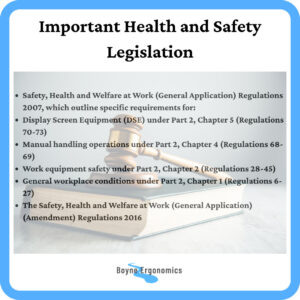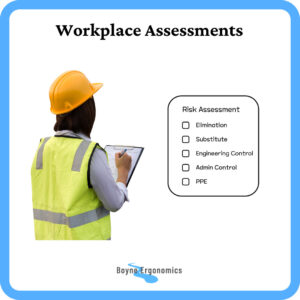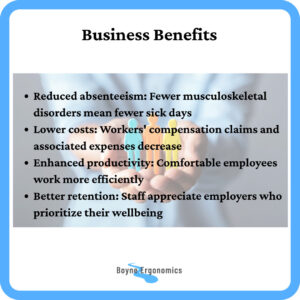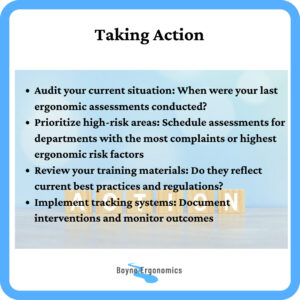Is your workplace truly safe and compliant with Irish regulations?
As World Day for Health and Safety at Work approaches on April 28th, it’s the perfect time to consider how ergonomics plays a critical role in not just employee comfort, but legal compliance as well.
At Boyne Ergonomics, we regularly see businesses surprised to learn the extent of their legal obligations regarding workplace ergonomics. Let’s explore what these requirements mean for your organisation and how proper ergonomic interventions can help you stay compliant.
Understanding Ireland’s Workplace Safety Framework
The Safety, Health and Welfare at Work Act 2005 forms the backbone of workplace safety regulations in Ireland. This comprehensive legislation isn’t just about preventing major accidents—it encompasses everyday ergonomic considerations that affect every employee.
The Act is reinforced by the Safety, Health and Welfare at Work (General Application) Regulations 2007, which outline specific requirements for:
- Display Screen Equipment (DSE) under Part 2, Chapter 5 (Regulations 70-73)
- Manual handling operations under Part 2, Chapter 4 (Regulations 68-69)
- Work equipment safety under Part 2, Chapter 2 (Regulations 28-45)
- General workplace conditions under Part 2, Chapter 1 (Regulations 6-27)
The Safety, Health and Welfare at Work (General Application) (Amendment) Regulations 2016 further updated some of these requirements to align with current best practices.

For employers, these aren’t optional guidelines—they represent legal obligations with serious consequences for non-compliance, including fines up to €3 million and potential imprisonment in severe cases.
What Does the Law Actually Require?
Display Screen Equipment Requirements
If your employees use computers, you’re legally required under Regulation 72 of the General Application Regulations 2007 to:
- Conduct proper workstation assessments
- Ensure workstations meet minimum ergonomic standards
- Provide information and training on DSE safety
- Implement work routines with regular breaks
- Offer appropriate eye tests for regular DSE users
Many organisations are surprised to learn that these assessments must be documented and updated whenever significant changes occur to workstations or work patterns.
Manual Handling Obligations
For tasks involving lifting, carrying, or moving objects, Regulations 68 and 69 require:
- Avoiding manual handling where possible through automation or mechanical assistance
- Assessing risks when manual handling can’t be avoided
- Implementing measures to reduce injury risk
- Providing specific training on proper techniques
These requirements apply to all workplaces—from offices to warehouses, retail environments to healthcare settings.
Special Considerations for Pregnant Employees
Did you know that ergonomic assessments take on additional legal significance for pregnant employees? The Safety, Health and Welfare at Work (General Application) Regulations 2007, Part 6, Chapter 2 (Protection of Pregnant, Post Natal and Breastfeeding Employees) requires:
- Specific risk assessments for pregnant workers
- Adjustment of working conditions to avoid identified risks
- Provision of suitable alternative work when necessary
- Health and safety leave when other measures aren’t sufficient
Practical Ergonomic Solutions for Compliance
1. Professional Workplace Assessments
A comprehensive ergonomic assessment does more than identify comfort issues—it documents your compliance efforts and catches problems before they result in injuries or regulatory issues.
Professional assessments evaluate:
- Workstation setup and equipment positioning
- Task design and workflow efficiency
- Environmental factors like lighting, noise, and temperature
- Employee work habits and posture
2. Equipment Selection and Proper Setup
One common compliance gap I see is organisations providing ergonomic equipment without ensuring proper setup and adjustment.
Compliant workstations typically include:
- Chairs with proper lumbar support and adjustability
- Monitors positioned at eye level, arm’s length away
- Keyboards and mice arranged to maintain neutral wrist positions
- Adequate space for movement and task completion
Remember: having ergonomic equipment isn’t enough—it must be properly adjusted for each individual employee.
3. Comprehensive Training Programmes
Training represents another crucial compliance element that’s often overlooked. Under Regulation 72(d) of the General Application Regulations, training must:
- Cover proper posture and working techniques
- Teach employees to adjust their own workstations
- Help workers recognize early signs of musculoskeletal issues
- Inform employees about their rights and responsibilities
Don’t forget to document all training sessions—this documentation is vital evidence of compliance during Health and Safety Authority (HSA) inspections.
4. Vehicle Ergonomics: Often Overlooked
For employees who drive as part of their work, vehicle ergonomics fall under the same regulatory framework. The Safety, Health and Welfare at Work (General Application) Regulations 2007 and guidance from the HSA on work-related vehicle safety apply here. Proper interventions include:
- Assessment of seating position and controls accessibility
- Evaluation of entry and exit procedures
- Review of loading and unloading methods
- Guidance on reducing exposure to whole-body vibration
5. Remote Work: Yes, You’re Still Responsible
With remote work now common across Ireland, it’s important to note that employers remain legally responsible for employee safety regardless of location, as clarified in the HSA Guidance on Working from Home Safety and Health.
Compliance for remote workers requires:
- Virtual assessments of home workspaces
- Provision of necessary equipment
- Remote training sessions
- Regular check-ins to monitor conditions
The Business Benefits Beyond Compliance
While avoiding penalties is certainly motivating, organisations that implement proper ergonomic interventions typically see additional benefits:
- Reduced absenteeism: Fewer musculoskeletal disorders mean fewer sick days
- Lower costs: Workers’ compensation claims and associated expenses decrease
- Enhanced productivity: Comfortable employees work more efficiently
- Better retention: Staff appreciate employers who prioritize their wellbeing
Taking Action This World Day for Health and Safety
As April 28th approaches, consider these practical steps to enhance your compliance:
- Audit your current situation: When were your last ergonomic assessments conducted?
- Prioritize high-risk areas: Schedule assessments for departments with the most complaints or highest ergonomic risk factors
- Review your training materials: Do they reflect current best practices and regulations?
- Implement tracking systems: Document interventions and monitor outcomes
How Boyne Ergonomics Can Help
At Boyne Ergonomics, we specialize in helping Irish organisations meet their legal obligations while creating healthier, more productive workplaces.
Our services include:
- Comprehensive DSE assessments (virtual and in-person)
- Ergonomic risk assessments tailored to your workplace
- Pregnancy risk assessments to ensure compliance with special requirements
- Vehicle ergonomic evaluations for driving employees
- Training and webinars on recognizing and reducing workplace ergonomic risks
Don’t wait for a workplace injury or HSA inspection to address your ergonomic compliance gaps. Contact us today to schedule a consultation and ensure your workplace is both safe and legally compliant.
This article was published in observation of World Day for Health and Safety at Work (April 28th, 2025). Boyne Ergonomics Ltd is dedicated to improving workplace health through professional ergonomic services across Ireland.









